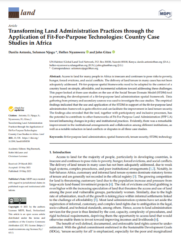
Access to land for many people in Africa is insecure and continues to pose risks to poverty, hunger, forced evictions, and social conflicts. The delivery of land tenure in many cases has not been adequately addressed. Fit-for-purpose spatial frameworks need to be adapted to the context of a country based on simple, affordable, and incremental solutions toward addressing these challenges. This paper looked at three case studies on the use of the Social Tenure Domain Model (STDM) tool in promoting the development of a fit-for-purpose land administration spatial framework. Data gathering from primary and secondary sources was used to investigate the case studies. The empirical findings indicated that the use and application of the STDM in support of the fit-for-purpose land administration framework is quite effective and can facilitate the improvement in land tenure security. The findings also revealed that the tool, together with participatory and inclusive processes, has the potential to contribute to other frameworks of Fit-For-Purpose Land Administration (FFP LA) toward influencing changes in policy and institutional practices. Evidently, there was a remarkable improvement in the institutional arrangements and collaboration among different institutions, as well as a notable reduction in land conflicts or disputes in all three case studies.
Source : MDPI via GLTN.
To download the publication, click on the link below :

Rejoignez-nous sur
LinkedIn